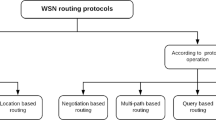Abstract
Recently, the energy efficiency is improved in the clustered wireless sensor networks (WSNs) using sink mobility in restricted path. However, due to path restriction, a constant speed is assigned with mobile sink and this has limited the time for communication to collect the sensor data in randomly deployed sensor networks. Further, the collection of sensor data increases the consumption of power in such network. Hence to improve this cluster based block wise compressed path constrained sensing is introduced in clustered sensor networks. Here, two techniques are deployed to reduce the consumption of power in sensor network. To limit the communication time in collecting the sensor data, the shortest path tree computation is used. Also, to reduce the inherent data sparsity block wise compression over spatially correlated data is used. The collection of data is done by the cluster heads and forwarded to the base stations (BSs) using shortest path tree computation. This is formulated as a mixed linear integer programming problem, which is solved using adaptive amoeba algorithm. The block wise compression method uses compressed sensing (CS) in clustered WSN and the measurement is done through block diagonal matrix. The forwarding of CS measurements is done through shortest path algorithm and this relays the measurements to the BSs. The validation is carried out in terms of total consumed power due to the effect of sparsity and transferring the CS measurements to BS. The performance is evaluated based on optimal clustering for attaining reduced power consumption. The experimental results show that the proposed method has higher throughput with increased energy efficiency than the other conventional methods.




Similar content being viewed by others
References
Mitici, M., Goseling, J., de Graaf, M., Boucherie, R.J.: Energy-efficient data collection in wireless sensor networks with time constraints. Perform. Eval 102, 34–52 (2016)
Kim, H.Y.: An energy-efficient load balancing scheme to extend lifetime in wireless sensor networks. Cluster Comput. 19(1), 279–283 (2016)
Donoho, D.L.: Compressed sensing. IEEE Trans. Inf. Theory 52(4), 1289–1306 (2006)
Candès, E.J., Wakin, M.B.: An introduction to compressive sampling. IEEE Signal Process. Mag 25(2), 21–30 (2008)
Haupt, J., Bajwa, W.U., Rabbat, M., Nowak, R.: Compressed sensing for networked data. IEEE Signal Process. Mag 25(2), 92–101 (2008)
Davenport, M.A., Laska, J.N., Treichler, J.R., Baraniuk, R.G.: The pros and cons of compressive sensing for wideband signal acquisition: noise folding versus dynamic range. IEEE Trans. Signal. Process 60(9), 4628–4642 (2012)
Rabbat, M., Haupt, J., Singh, A., Nowak, R.: Decentralized compression and predistribution via randomized gossiping. In: Proceedings of the 5th International Conference on Information processing in sensor networks, pp. 51–59. ACM (2006)
Wang, J., Tang, S., Yin, B., Li, X.Y.: Data gathering in wireless sensor networks through intelligent compressive sensing. In: INFOCOM, 2012 Proceedings IEEE, pp. 603-611. IEEE (2012)
Nguyen, M. T., Rahnavard, N.: Cluster-based energy-efficient data collection in wireless sensor networks utilizing compressive sensing. In: Military Communications Conference, MILCOM 2013–2013 IEEE, pp. 1708-1713. IEEE (2013)
Luo, C., Wu, F., Sun, J., Chen, C.W.: Efficient measurement generation and pervasive sparsity for compressive data gathering. IEEE Trans. Wirel. Commun. 9(12), 3728–3738 (2010)
Nguyen, M.T.: Minimizing energy consumption in random walk routing for wireless sensor networks utilizing compressed sensing. In: System of Systems Engineering (SoSE), 2013 8th International Conference on IEEE. pp. 297-301 (2013)
Nguyen, M.T., Teague, K.A.: Compressive sensing based random walk routing in wireless sensor networks. Ad Hoc Netw. 54, 99–110 (2017)
Yin, J., Yang, Y., Wang, L., Yan, X.: A reliable data transmission scheme based on compressed sensing and network coding for multi-hop-relay wireless sensor networks. Comput. Electr. Eng. 56, 366–384 (2016)
Hao, J., Zhang, B., Jiao, Z., Mao, S.: Adaptive compressive sensing based sample scheduling mechanism for wireless sensor networks. Pervasive Mob. Comput. 22, 113–125 (2015)
Sun, B., Guo, Y., Li, N., Peng, L., Fang, D.: TDL: two-dimensional localization for mobile targets using compressive sensing in wireless sensor networks. Comput. Commun. 78, 45–55 (2016)
Mangia, M., Bortolotti, D., Pareschi, F., Bartolini, A., Benini, L., Rovatti, R., Setti, G.: Zeroing for HW-efficient compressed sensing architectures targeting data compression in wireless sensor networks. Microprocess. Microsyst. 48, 69–79 (2017)
Xiao, F., Ge, G., Sun, L., Wang, R.: An energy-efficient data gathering method based on compressive sensing for pervasive sensor networks. Pervasive Mob. Comput. (2017)
He, J., Sun, G., Li, Z., Zhang, Y.: Compressive data gathering with low-rank constraints for wireless sensor networks. Signal Process. 131, 73–76 (2017)
Masoum, A., Meratnia, N., Havinga, P.J.: A distributed compressive sensing technique for data gathering in wireless sensor networks. Proced. Comput. Sci. 21, 207–216 (2013)
Liang, J., Mao, C.: Distributed compressive sensing in heterogeneous sensor network. Signal Process. 126, 96–102 (2016)
Ebrahimi, D., Assi, C.: Compressive data gathering using random projection for energy efficient wireless sensor networks. Ad Hoc Netw. 16, 105–119 (2014)
Lv, C., Wang, Q., Yan, W., Shen, Y.: Energy-balanced compressive data gathering in wireless sensor networks. J. Netw. Comput. Appl. 61, 102–114 (2016)
Valley, G.C., Sefler, G.A., Shaw,T.J.: Photonic technologies for undersampling and compressive sensing of high-speed RF signals. In: Optical Fiber Communications Conference and Exhibition (OFC), IEEE. (2016)
Gottardi, G., Turrina, L., Anselmi, N., Oliveri, G., Rocca, P.: Sparse conformal array design for multiple patterns generation through Multi-Task Bayesian Compressive Sensing. In: Antennas and Propagation and USNC/URSI National Radio Science Meeting, 2017 IEEE International Symposium on, pp. 429–430. IEEE (2017)
Shahrasbi, B., Rahnavard, N.: Model-based nonuniform compressive sampling and recovery of natural images utilizing a wavelet-domain universal hidden Markov model. IEEE Trans. Signal Process. 65(1), 95–104 (2017)
Milyeykovski, V., Segal, M., Katz, V.: Using central nodes for efficient data collection in wireless sensor networks. Comput. Netw 91, 425–437 (2015)
Handy, M.J., Haase, M., Timmermann, D.: Low energy adaptive clustering hierarchy with deterministic cluster-head selection. In: Mobile and Wireless Communications Network, 2002. 4th International Workshop on, pp. 368-372. IEEE (2002)
Wieselthier, J.E., Nguyen, G.D., Ephremides, A.: Energy-efficient broadcast and multicast trees in wireless networks. Mob. Netw. Appl. 7(6), 481–492 (2002)
Rappaport, T.S.: Wireless communications–principles and practice, (the book end). Microwave J. 45(12), 128–129 (2002)
Berinde, R., Indyk, P.: Sparse recovery using sparse random matrices. Preprint (2008)
Candès, E.J., Romberg, J., Tao, T.: Robust uncertainty principles: exact signal reconstruction from highly incomplete frequency information. IEEE Trans. Inf. Theory 52(2), 489–509 (2006)
MacQueen, J.: Some methods for classification and analysis of multivariate observations. In: Proceedings of the Fifth Berkeley Symposium on Mathematical Statistics and Probability, vol. 1, No. 14, pp. 281-297. (1967)
Zhang, S., Wang, H., Huang W.: Two-stage plant species recognition by local mean clustering and weighted sparse representation classification. Cluster Comput. pp. 1-9 (2017)
Qin, S., Yin, J.: A Robust Sparsity Estimation Method in Compressed Sensing. In: China Conference on Wireless Sensor Networks, pp. 481-488. Springer, Berlin, Heidelberg (2014)
Author information
Authors and Affiliations
Corresponding author
Rights and permissions
About this article
Cite this article
Lakshminarayanan, R., Rajendran, P. Efficient data collection in wireless sensor networks with block-wise compressive path constrained sensing in mobile sinks. Cluster Comput 22 (Suppl 4), 9755–9766 (2019). https://doi.org/10.1007/s10586-017-1482-3
Received:
Revised:
Accepted:
Published:
Issue Date:
DOI: https://doi.org/10.1007/s10586-017-1482-3




